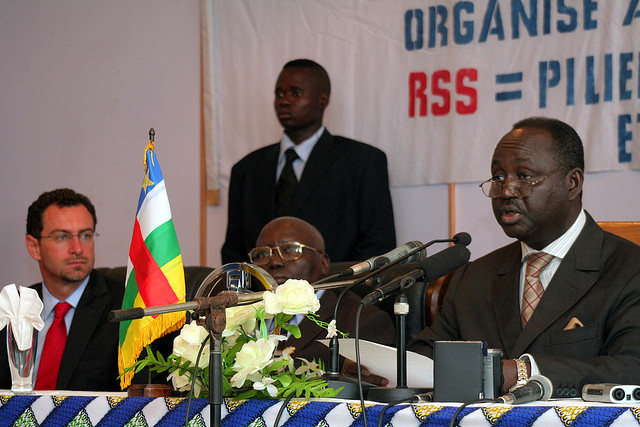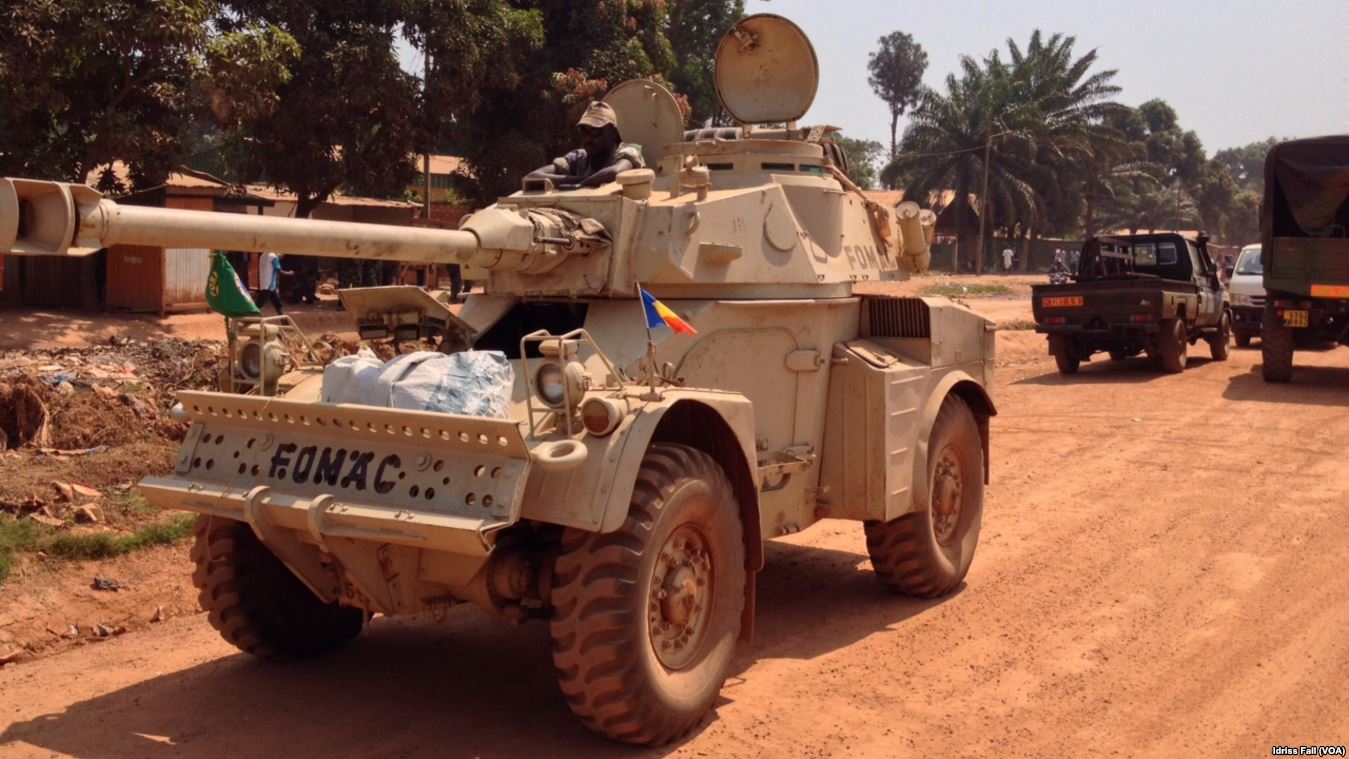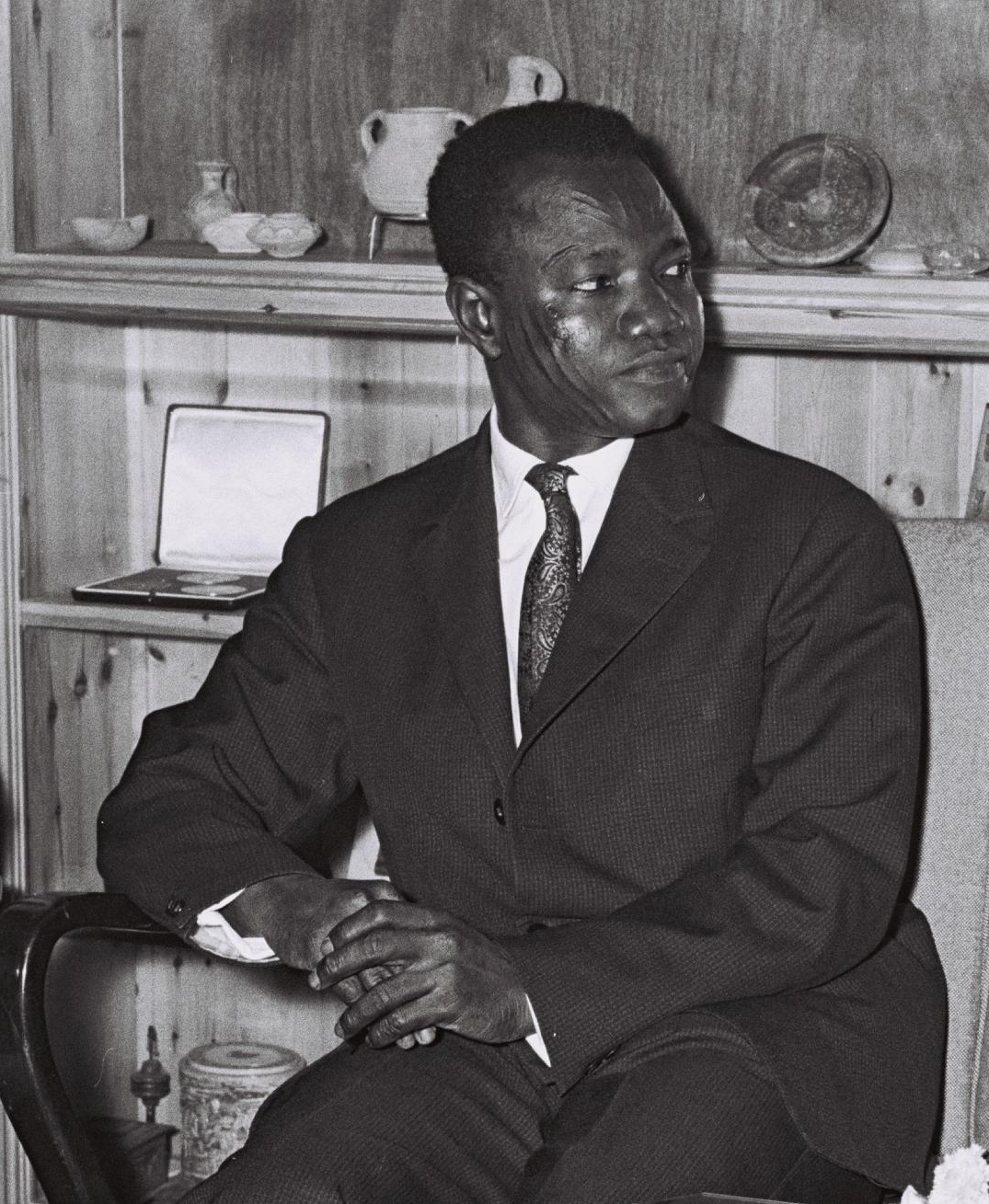|
2003 Central African Republic Coup D'état
A coup d'état occurred in March 2003 in the Central African Republic when the forces of General François Bozizé marched on Bangui, the country's capital, while President Ange-Félix Patassé was at a regional conference in Niger. Background On 25 October 2002 forces local to Bozize invaded Bangui. They withdrew after six days of fighting. On 27 November 2002 armed forces recaptured Bossembele killing five rebels and reopening road to Bouar. On 7 December armed forces recaptured Damara from rebels. On 20 December armed forces recaptured Bozoum. On 14 January 2003 Bouar was reportedly under rebels control. Coup While Patassé was away, Bozizé led 1,000 fighters to the capital city of Bangui and captured the international airport and the presidential palace. Government troops, many of whom had not been paid in months, put up little resistance. The 370 CEMAC peacekeepers abandoned their posts rather than fight. A curfew was imposed afterwards by Bozizé and the constitutio ... [...More Info...] [...Related Items...] OR: [Wikipedia] [Google] [Baidu] |
François Bozizé
François Bozizé Yangouvonda (born 14 October 1946) is a Central African politician who was President of the Central African Republic from 2003 to 2013. Bozizé rose to become a high-ranking army officer in the 1970s, under the rule of Jean-Bédel Bokassa. After Bokassa was ousted, Bozizé served in the government as Minister of Defense from 1979 to 1981 and as Minister of Information from 1981 to 1982. He participated in a failed 1982 coup attempt against President André Kolingba and subsequently fled the country. Years later, he served as Army Chief of Staff under President Ange-Félix Patassé, but he began a rebellion against Patassé in 2001. Bozizé's forces captured the capital, Bangui, in March 2003, while Patassé was outside the country, and Bozizé took power, ushering in a transitional period of government. He won the March–May 2005 presidential election in a second round of voting, and he was re-elected in the January 2011 presidential election, winning the vo ... [...More Info...] [...Related Items...] OR: [Wikipedia] [Google] [Baidu] |
Renaissance Palace
The Renaissance Palace is the official residence of the President of the Central African Republic, located in the 1st arrondissement of Bangui ( :fr:1er arrondissement de Bangui), at the foot of Gbazabangui Hill and facing the ''PK zéro''. History The original building with verandas was built in French Colonial style from 1917 to 1920 by Victor Henri Sisson. The palace was the residence of the Governor of Ubangi-Shari Stephen Smith, Géraldine Faes, ''Bokassa Ier un empereur français'', Calmann-Lévy, 29 mars 2000 until 1960, when the country gained independence from France and the palace became the seat of the President of the Republic. The palace was reconstructed during the rule of Jean-Bédel Bokassa (1966–1979). During the final three years of Bokassa’s rule, the leader served as the Emperor of Central Africa Emperor of Central Africa (french: Empereur de Centrafrique) was the title used by Jean-Bédel Bokassa from 4 December 1976, who was crowned on 4 December ... [...More Info...] [...Related Items...] OR: [Wikipedia] [Google] [Baidu] |
Military Coups In The Central African Republic
A military, also known collectively as armed forces, is a heavily armed, highly organized force primarily intended for warfare. It is typically authorized and maintained by a sovereign state, with its members identifiable by their distinct military uniform. It may consist of one or more military branches such as an army, navy, air force, space force, marines, or coast guard. The main task of the military is usually defined as defence of the state and its interests against external armed threats. In broad usage, the terms ''armed forces'' and ''military'' are often treated as synonymous, although in technical usage a distinction is sometimes made in which a country's armed forces may include both its military and other paramilitary forces. There are various forms of irregular military forces, not belonging to a recognized state; though they share many attributes with regular military forces, they are less often referred to as simply ''military''. A nation's military may f ... [...More Info...] [...Related Items...] OR: [Wikipedia] [Google] [Baidu] |
2000s Coups D'état And Coup Attempts
S, or s, is the nineteenth letter in the Latin alphabet, used in the modern English alphabet, the alphabets of other western European languages and others worldwide. Its name in English is ''ess'' (pronounced ), plural ''esses''. History Origin Northwest Semitic šîn represented a voiceless postalveolar fricative (as in 'ip'). It originated most likely as a pictogram of a tooth () and represented the phoneme via the acrophonic principle. Ancient Greek did not have a phoneme, so the derived Greek letter sigma () came to represent the voiceless alveolar sibilant . While the letter shape Σ continues Phoenician ''šîn'', its name ''sigma'' is taken from the letter ''samekh'', while the shape and position of ''samekh'' but name of ''šîn'' is continued in the '' xi''. Within Greek, the name of ''sigma'' was influenced by its association with the Greek word (earlier ) "to hiss". The original name of the letter "sigma" may have been ''san'', but due to the complica ... [...More Info...] [...Related Items...] OR: [Wikipedia] [Google] [Baidu] |
Conflicts In 2003
Conflict may refer to: Arts, entertainment, and media Films *Conflict (1921 film), ''Conflict'' (1921 film), an American silent film directed by Stuart Paton * Conflict (1936 film), ''Conflict'' (1936 film), an American boxing film starring John Wayne * Conflict (1937 film), ''Conflict'' (1937 film), a Swedish drama film directed by Per-Axel Branner * Conflict (1938 film), ''Conflict'' (1938 film), a French drama film directed by Léonide Moguy * Conflict (1945 film), ''Conflict'' (1945 film), an American suspense film starring Humphrey Bogart * Catholics (film), ''Catholics: A Fable'' (1973 film), or ''The Conflict'', a film starring Martin Sheen * Judith (1966 film), ''Judith'' (1966 film) or ''Conflict'', a film starring Sophia Loren * Samar (1999 film), ''Samar'' (1999 film) or ''Conflict'', a 1999 Indian film by Shyam Benegal Games * Conflict (series), ''Conflict'' (series), a 2002–2008 series of war games for the PS2, Xbox, and PC * Conflict (video game), ''Conf ... [...More Info...] [...Related Items...] OR: [Wikipedia] [Google] [Baidu] |
Central African Republic Civil War
{{Infobox military conflict , conflict = Central African Republic Civil War , image = , caption = Current military situation in Central African Republic (For a detailed map of the current military situation, see Template:Central African Republic Civil War detailed map, here) , date = 10 December 2012 – present({{Age in years, months, weeks and days, month1=12, day1=10, year1=2012) , place = Central African Republic(Possible spillover into East Region (Cameroon), East Region, Cameroon)Rebels Attack Cameroonian Town Close To Central African Republic HumAngle, 11 Mar 2021. Accessed 11 Apr 2021. , result = Ongoing conflicts, Ongoing * Séléka rebel coalition take ... [...More Info...] [...Related Items...] OR: [Wikipedia] [Google] [Baidu] |
Central African Republic Bush War
The Central African Republic Bush War was a civil war in the Central African Republic between Union of Democratic Forces for Unity (UFDR) rebels and government forces. The rebellion began after François Bozizé seized the nation's presidency in 2003. Actual fighting began in 2004. Around 10,000 people were displaced because of the civil unrest. The rebellion consisted of multiple rebel groups, several of which were of very small size and founded only towards the end of the conflict. Apart from the UFDR, the conflict included the People's Army for the Restoration of Democracy (CAR) (APRD), Groupe d'action patriotique pour la liberation de Centrafrique (GAPLC), the Movement of Central African Liberators for Justice (MLCJ), the Front démocratique Centrafricain (FDC), and Union of Republican Forces (UFR). A number of peace agreements have been signed to resolve the conflict between 2007 and 2012. The most important agreement, the Global Peace Accord (signed in Libreville, ... [...More Info...] [...Related Items...] OR: [Wikipedia] [Google] [Baidu] |
Military Of Chad
french: Armée nationale tchadienne , image = , alt = , caption = , image2 = , alt2 = , caption2 = , motto = , founded = 1969 , current_form = , disbanded = , branches = , headquarters = N'Djamena , flying_hours = , website = , commander-in-chief = Corps General Mahamat Déby Itno , commander-in-chief_title = Commander-in-Chief , chief minister = , chief minister_title = , minister = Bichara Issa Djadallah , minister_title = Minister of Defence , commander = Azem Bermendoa Agouna , commander_title = Chief of the General Staff , age = 18 years of age , conscription = Yes , manpower_data = , manpower_a ... [...More Info...] [...Related Items...] OR: [Wikipedia] [Google] [Baidu] |
Idriss Déby
Idriss Déby Itno ' (18 June 1952 – 20 April 2021) was a Chadian politician and military officer who was the president of Chad from 1990 until his death in 2021. Déby was a member of the Bidayat clan of the Zaghawa ethnic group. A high-ranking commander of President Hissène Habré's military during the 1980s, Déby played important roles in the Toyota War which led to Chad's victory during the Libyan-Chadian conflict. He was later purged by Habré after being suspected of plotting a coup, and was forced into exile in Libya. He took power by leading a coup d'état against Habré in December 1990. Despite introducing a multi-party system in 1992 after several decades of one-party rule under his predecessors, throughout his presidency, his Patriotic Salvation Movement was the dominant party. Déby won presidential elections in 1996 and 2001, and after term limits were eliminated he won again in 2006, 2011, 2016, and 2021. During the Second Congo War, Déby briefly ordered mili ... [...More Info...] [...Related Items...] OR: [Wikipedia] [Google] [Baidu] |
List Of Heads Of State Of Chad
This is a list of heads of state of Chad since the country gained independence from France in 1960 to the present day. A total of six people have served as head of state of Chad (not counting two Interim Heads of State). Additionally, one person, Goukouni Oueddei, has served on two non-consecutive occasions. The current head of state of Chad is Transitional President Mahamat Déby, since 20 April 2021 following the death of his father, Idriss Déby. Déby was President of the Transitional Military Council, a military junta, from 20 April 2021 until 10 October 2022, when he was sworn is as Transitional President following a "national dialogue". Titles * 1960–1962: Head of State * 1962–1975: President of the Republic * 1975: Chairman of the Supreme Military Council * 1975–1978: Head of State * 1978–1979: President of the Republic * 1979: Chairman of the Provisional Council of State * 1979: President of the Transitional Government of National Unity * 1979: Chairman of ... [...More Info...] [...Related Items...] OR: [Wikipedia] [Google] [Baidu] |
Chad
Chad (; ar, تشاد , ; french: Tchad, ), officially the Republic of Chad, '; ) is a landlocked country at the crossroads of North and Central Africa. It is bordered by Libya to the north, Sudan to the east, the Central African Republic to the south, Cameroon to the southwest, Nigeria to the southwest (at Lake Chad), and Niger to the west. Chad has a population of 16 million, of which 1.6 million live in the capital and largest city of N'Djamena. Chad has several regions: a desert zone in the north, an arid Sahelian belt in the centre and a more fertile Sudanian Savanna zone in the south. Lake Chad, after which the country is named, is the second-largest wetland in Africa. Chad's official languages are Arabic and French. It is home to over 200 different ethnic and linguistic groups. Islam (55.1%) and Christianity (41.1%) are the main religions practiced in Chad. Beginning in the 7th millennium BC, human populations moved into the Chadian basin in great numbe ... [...More Info...] [...Related Items...] OR: [Wikipedia] [Google] [Baidu] |
Cameroon
Cameroon (; french: Cameroun, ff, Kamerun), officially the Republic of Cameroon (french: République du Cameroun, links=no), is a country in west-central Africa. It is bordered by Nigeria to the west and north; Chad to the northeast; the Central African Republic to the east; and Equatorial Guinea, Gabon and the Republic of the Congo to the south. Its coastline lies on the Bight of Biafra, part of the Gulf of Guinea and the Atlantic Ocean. Due to its strategic position at the crossroads between West Africa and Central Africa, it has been categorized as being in both camps. Its nearly 27 million people speak 250 native languages. Early inhabitants of the territory included the Sao civilisation around Lake Chad, and the Baka hunter-gatherers in the southeastern rainforest. Portuguese explorers reached the coast in the 15th century and named the area ''Rio dos Camarões'' (''Shrimp River''), which became ''Cameroon'' in English. Fulani soldiers founded the Adamawa Emirate ... [...More Info...] [...Related Items...] OR: [Wikipedia] [Google] [Baidu] |


